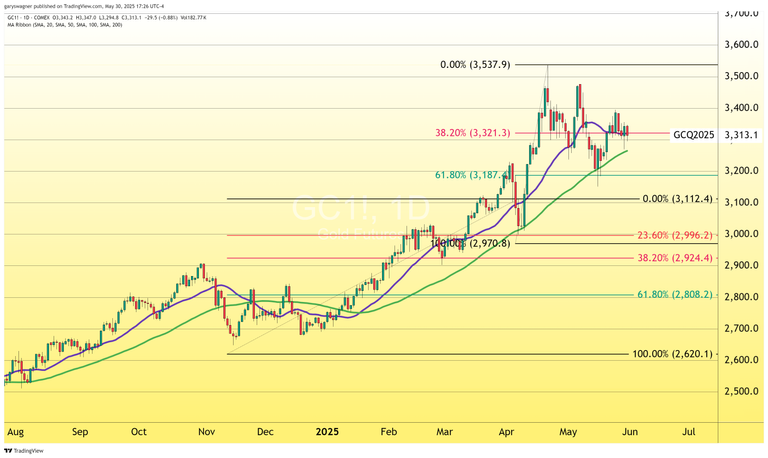Gold futures encountered significant headwinds on Friday, closing down $27.70 or 0.84% at 4:45 PM Eastern Standard Time, extending weekly losses to approximately $71 or 2.09% and a 0.3% decline on the month. The precious metal's decline coincided with encouraging inflation data that strengthened the U.S. dollar and reinforced expectations for prolonged higher interest rates.

May marked gold futures' first losing month of 2025, though the modest 0.33% decline created a notable technical formation. Despite the red monthly candle, the minimal price movement from the monthly open to monthly close generated a Doji candlestick occurs when opening and closing prices are nearly identical. This same technical pattern simultaneously appeared in the U.S. Dollar Index, which paradoxically continued its four-month losing streak while forming the indecisive candle structure.

The Doji represents a critical inflection point in technical analysis, signaling potential reversals particularly when emerging after strong directional trends or at significant support and resistance levels. For gold, this pattern arrives after months of sustained gains in the spot market, where the metal has maintained an impressive five-month winning streak despite futures closing slightly lower on the month.
Friday's selling pressure intensified following the release of April's Personal Consumption Expenditures data, the Federal Reserve's preferred inflation gauge. The PCE Index rose 2.1% annually, declining from March's 2.3% pace and falling short of the 2.2% FactSet consensus. Core PCE, which excludes volatile food and energy components, moderated to 2.5% from the previous month's 2.7% reading while meeting the analyst’s expectations.
These encouraging inflation readings immediately energized dollar bulls, propelling the ICE Dollar Index 0.2 points higher to 99.29. The currency's strength created direct pressure on gold, as dollar appreciation traditionally diminishes the metal's international attractiveness and elevates its relative purchase cost for foreign investors.
Complementing the inflation data, personal income figures exceeded expectations in April, while expenditure and price growth aligned with forecasts. These results collectively reinforced the Federal Reserve's anticipated pause at its June 18 policy meeting, with markets widely expecting officials to maintain current interest rate levels. The prospect of prolonged higher rates increases gold's opportunity cost, as the non-yielding asset becomes less attractive relative to interest-bearing alternatives.
The emergence of Doji patterns in both gold futures and the dollar index suggests markets may be approaching a technical decision point. For gold, the combination of mixed fundamental signals—declining futures versus resilient spot prices—and the appearance of this reversal pattern warrants close monitoring in coming sessions. Confirmation of the Doji candlestick reversal implications would require decisive price action beyond the pattern's trading range, potentially signaling either a resumption of gold's longer-term uptrend or validation of emerging bearish pressures.
Gold's technical landscape reflects the broader uncertainty surrounding the ongoing trade talks along with Federal Reserve policy timing and the sustainability of the dollar's recent weakness. The precious metal's response to these crosscurrents in the sessions ahead may determine whether the doji candlestick represents a mere pause in gold's advance or the beginning of a more significant correction.
For those who wish to learn more about our service, please go to: Gold Forecast
Wishing you as always good trading,

